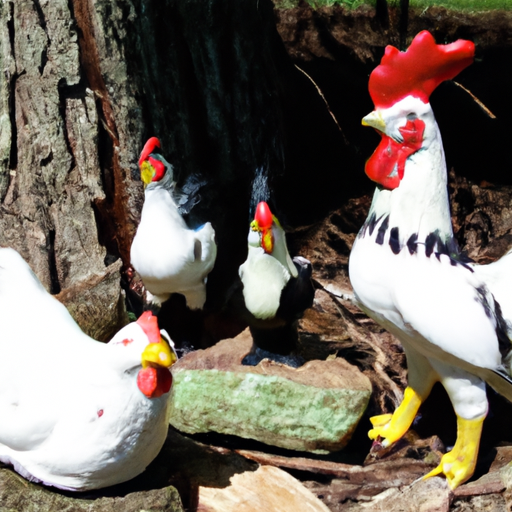Have you ever wondered if different chicken breeds require different amounts of space? Well, your curiosity is about to be satisfied, as we explore the topic of specific space considerations for certain chicken breeds. Whether you have a small backyard or a sprawling farm, understanding the spatial needs of different chicken breeds is essential for their health and well-being. From the petite bantams to the majestic Brahmas, we will uncover the varying space requirements that accommodate these feathered friends. So, gather ’round and let’s embark on a journey to discover the perfect balance between comfort and freedom for our beloved chickens. Yes, there are indeed specific space considerations for different chicken breeds. The needs and requirements of chickens can vary depending on the breed, which means that the amount of space they require may differ as well. To ensure the health and well-being of your chickens, it is important to understand these space considerations and provide them with an appropriate environment.
Types of Chicken Breeds
Before we delve into the specific space requirements for different breeds, let’s first familiarize ourselves with the different types of chicken breeds. There are several categories of chicken breeds, each with its own unique characteristics and purposes. These include standard breeds, bantam breeds, dual-purpose breeds, egg-laying breeds, and meat breeds.
Standard Breeds
Standard breeds are the most common type of chicken breeds that you will come across. They are the standard size chickens that you see in most backyard flocks or on farms. Examples of standard breeds include Rhode Island Reds, Plymouth Rocks, and Leghorns.
Bantam Breeds
Bantam breeds are smaller versions of standard breeds. They are often chosen for their adorable size and ornamental qualities. Bantam breeds include Silkies, Sebrights, and Pekins.
Dual-Purpose Breeds
Dual-purpose breeds are specifically bred for both meat and egg production. They are larger in size compared to standard breeds and provide a good balance of meat and egg laying capabilities. Popular dual-purpose breeds include Sussex, Orpingtons, and Wyandottes.
Egg-Laying Breeds
As the name suggests, egg-laying breeds are primarily bred for their ability to produce a high number of eggs. They have a smaller body size and tend to be more focused on egg production rather than meat. Examples of egg-laying breeds are Leghorns, Australorps, and ISA Browns.
Meat Breeds
Meat breeds, also known as broilers, are specifically bred for their rapid growth and high meat production. They have a larger body size compared to other breeds and are the main choice for commercial meat production. Popular meat breeds include Cornish Cross, Freedom Rangers, and Jersey Giants.
Now that we have a better understanding of the different types of chicken breeds, let’s explore the space requirements for each category. Understanding the specific needs of each breed will help you plan and design an appropriate living space for your feathered friends.
Space Requirements for Chicken Breeds
When it comes to providing adequate space for your chickens, there are several different aspects to consider. These include the minimum coop size, outdoor run or space, vertical space, nesting boxes, and roosting bars. Let’s take a closer look at each of these considerations.
Minimum Coop Size
Regardless of the breed, chickens require a minimum amount of indoor space in their coop. This space is crucial for their protection from predators and the elements, as well as providing a comfortable and secure environment. As a general rule of thumb, each chicken should have approximately 4 square feet of coop space. However, this number can vary depending on the size of the breed and the intended purpose of your flock.
Run or Outdoor Space
In addition to the indoor coop, chickens also need ample outdoor space to roam and engage in natural behaviors. The amount of outdoor space required can vary depending on the breed and their activity levels. As a general guideline, each chicken should have at least 10 square feet of outdoor space. However, if you have limited space, you can consider increasing this number by providing them with rotational access to different areas of your yard.
Vertical Space
Chickens also require vertical space within their coop to perch or roost at night. Roosting is an important behavior for chickens as it provides them with a sense of security and allows them to rest comfortably. Each chicken should have at least 8 inches of roosting space, with the roosting bars placed higher than the nesting boxes to avoid soiling.
Nesting Boxes
If you are keeping chickens primarily for their egg-laying capabilities, you need to provide them with suitable nesting boxes. Nesting boxes should be dark, private, and comfortable to encourage hens to lay their eggs in them. As a general guideline, one nesting box should be provided for every 3-4 hens, with each box measuring around 12×12 inches.
Roosting Bars
Roosting bars are essential for chickens to rest comfortably at night. They should be placed higher than the nesting boxes and be wide enough for the chickens to comfortably perch. As a general rule, each chicken should have approximately 8 inches of roosting bar space.
Now that we have covered the general space requirements for all chicken breeds, let’s explore the specific considerations for each breed category.
Standard Breeds
Standard breeds, being the most common type of chicken breeds, have relatively straightforward space requirements. As mentioned earlier, each chicken should have approximately 4 square feet of coop space. Additionally, outdoor space should be provided at a rate of 10 square feet per chicken. Standard breeds generally have moderate-sized bodies, so they do not require excessive vertical space or larger nesting boxes.
Bantam Breeds
Bantam breeds, being smaller in size, have slightly different space considerations compared to standard breeds. While they still require 4 square feet of coop space per chicken, their smaller bodies mean that they can thrive with slightly less outdoor space. Providing them with around 8-10 square feet of outdoor space per chicken should be sufficient. The smaller size of breed also means that they can comfortably roost in narrower and shorter roosting bars.
Dual-Purpose Breeds
Dual-purpose breeds, being larger and more robust, have slightly different space requirements compared to other breed categories. Each chicken should have approximately 6-8 square feet of coop space, as their larger bodies require more room to move around comfortably. The same rule applies to outdoor space, with each chicken requiring at least 10 square feet. It is also recommended to provide them with slightly wider and longer roosting bars to accommodate their larger size.
Egg-Laying Breeds
Egg-laying breeds, being smaller in size and more focused on egg production, have similar space requirements to standard breeds. Each chicken should have around 4 square feet of coop space and at least 10 square feet of outdoor space. However, it is important to note that egg-laying breeds may require larger nesting boxes to ensure they have a comfortable and private space to lay their eggs.
Meat Breeds
Meat breeds, being the largest in size, have the most specific space requirements. Each chicken should have approximately 8-10 square feet of coop space to comfortably move around. Similarly, they require ample outdoor space, with a recommended ratio of 20 square feet per chicken. It is also crucial to provide them with wider and longer roosting bars to accommodate their larger size.
Factors Affecting Space Considerations
While we have discussed the specific space requirements for different chicken breeds, it is important to note that there are several factors that can affect these considerations.
Climate
The climate in which you live can greatly impact the space requirements for your chickens. In areas with extreme weather conditions, chickens may require larger coops to provide adequate shelter and protection. Additionally, in colder climates, chickens will require more space to move around and exercise to generate body heat and maintain their well-being.
Breed Size
As we have discussed throughout this article, the size of the breed plays a significant role in determining their space requirements. Larger breeds will generally require more space to move comfortably and engage in natural behaviors, while smaller breeds can thrive in slightly smaller spaces.
Behavioral Traits
Different chicken breeds have different behavioral traits that can also influence their space requirements. Some breeds may be more active and require additional space for exercise, while others may be calmer and require less space. Understanding the specific traits of the breed you choose will help you determine the appropriate space requirements.
Intended Purpose
The intended purpose of your flock can also affect the space considerations you need to take into account. If you are primarily keeping chickens for meat production, larger coop and outdoor space would be required. Conversely, if you are focusing on egg production, providing larger nesting boxes or additional roosting space may be a priority.
Importance of Proper Space for Chickens
Providing chickens with proper space and living conditions is crucial for their overall health, well-being, and productivity. By ensuring they have adequate space, you are promoting their natural behaviors and reducing the risk of health issues and stress-related problems.
Health and Well-being
Proper space allows chickens to move around and exercise, promoting good physical health and reducing the risk of obesity and related health problems. It also helps prevent the spread of diseases and parasites, as overcrowding can lead to a compromised immune system. A healthier flock is less prone to illnesses and can lead to reduced veterinarian visits and medical expenses.
Reducing Stress and Aggression
Overcrowding in a confined space can lead to increased stress levels and aggression among chickens. By providing them with ample space, you can reduce stress and prevent aggressive behaviors such as pecking and bullying. This creates a more harmonious environment for your flock and reduces the risk of injuries.
Encouraging Natural Behaviors
When chickens have enough space to roam and explore, they are more likely to engage in natural behaviors such as scratching, dust bathing, and foraging for food. These activities are not only important for their mental well-being but also provide exercise and stimulation. By allowing them to express these natural behaviors, you are promoting their overall happiness and contentment.
In conclusion, providing appropriate space for your chickens is essential for their health, well-being, and productivity. By considering the specific space requirements for different breed categories and understanding the factors that can influence these considerations, you can create an environment that supports their natural behaviors and ensures a happy and thriving flock. Remember, a well-designed space leads to healthier and happier chickens!




